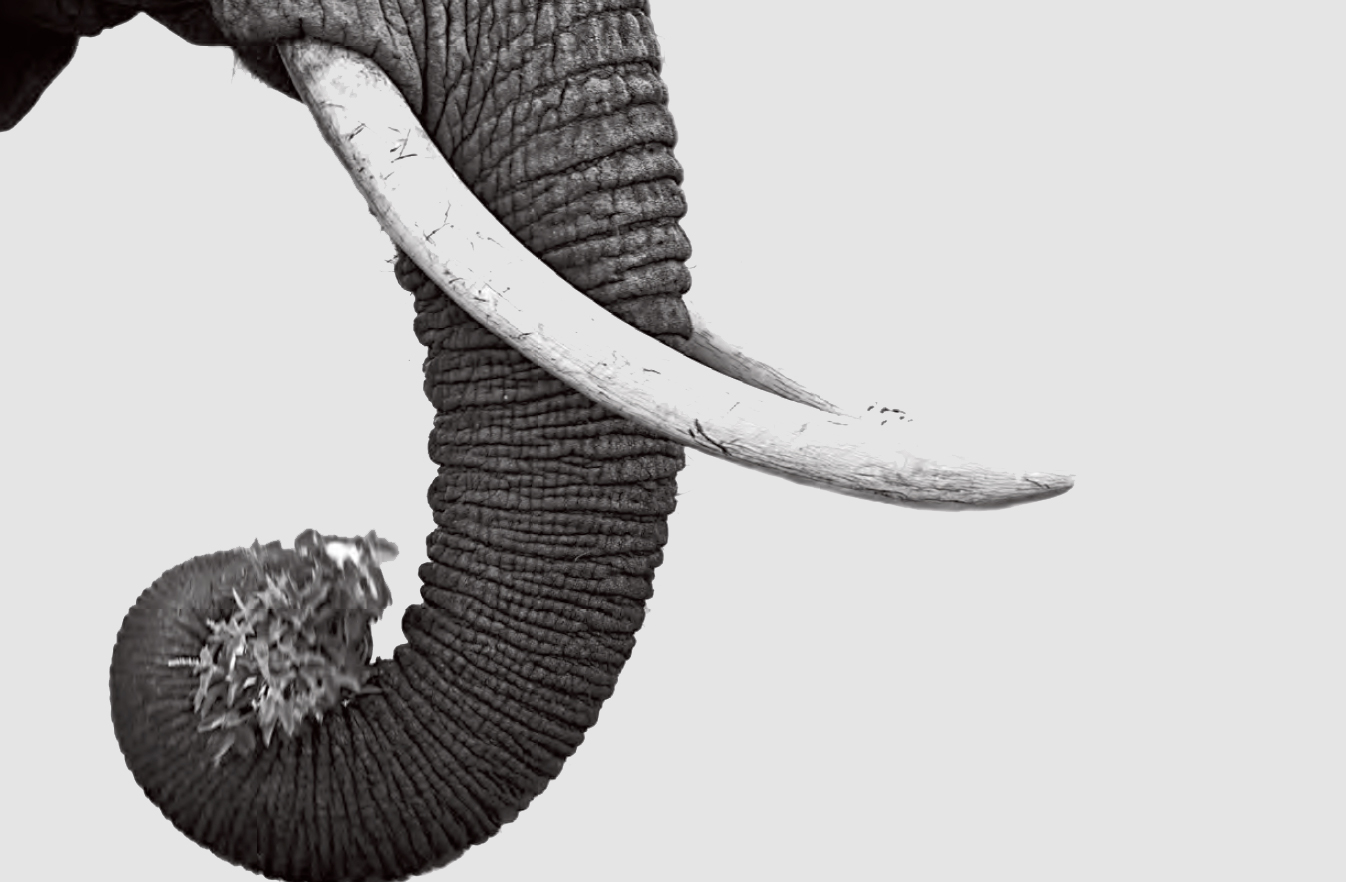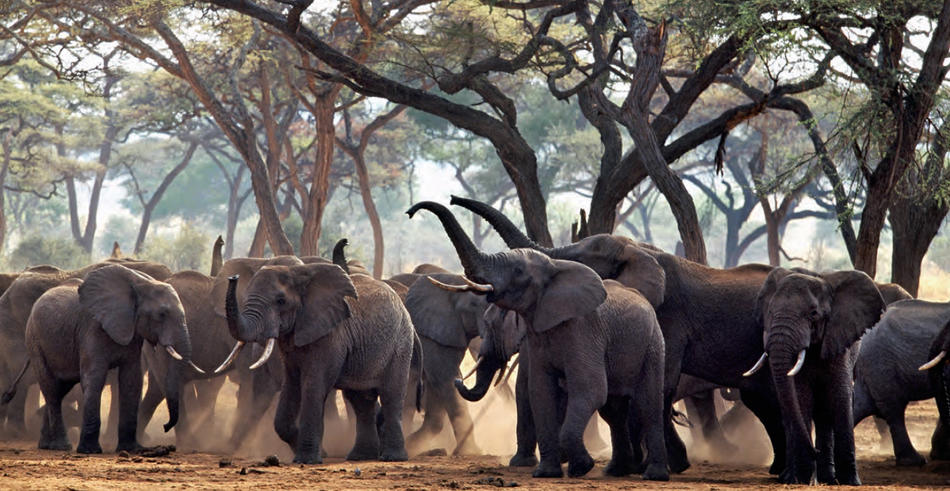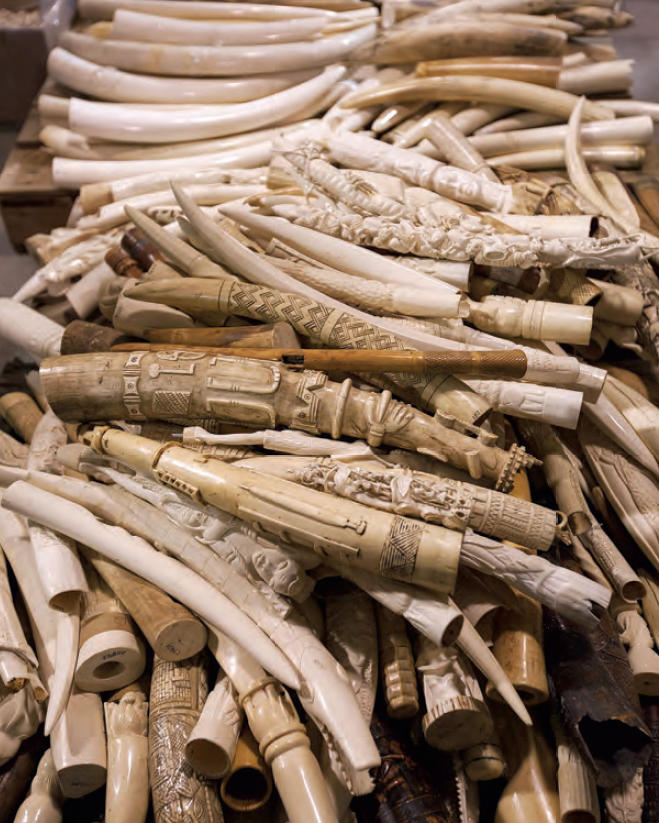
In December 2013, Kevin Uno, a postdoctoral researcher at Columbia’s Lamont-Doherty Earth Observatory, received a phone call from Todd Kish at Canada’s environmental protection agency. Kish told Uno that the Canadian government had confiscated two elephant tusks from an auction house in Toronto.
Uno had been waiting for a call like this. As a graduate student in geology at the University of Utah from 2005 to 2012, he had worked on a technique for radiocarbon-dating elephant tusks, hoping, he says, “to see how fast they grow, and to use them as a sort of ecological tape recorder of an elephant’s life.”
But tusks aren’t just any animal tissue. They are made of ivory, called “white gold” in China, a precious commodity for which African elephants are being butchered to the brink of oblivion. The Wildlife Conservation Society (WCS) estimates that thirty-six thousand African elephants were killed in 2012. Savanna elephants, the world’s largest land mammals, which numbered five to ten million a century ago, have fallen to four hundred thousand. Forest elephants, found in central Africa, have declined by 65 percent in the past twelve years, leaving about one hundred thousand. At this rate, the WCS warns, the forest elephant could disappear in the next decade.
It wasn’t long before Uno realized his method for dating ivory could be a tool in the battle for the elephants.
The need for such a tool flowed from the porousness of the law. In 1989, amid a poaching frenzy in Africa driven by ivory demand in the US, Japan, and Europe, the world decided to act. The United Nations had implemented the Convention on International Trade in Endangered Species of Wild Fauna and Flora (CITES) in 1975 to address the sustainability of the world’s natural resources. Now, with elephants dying at unprecedented rates, the CITES signatories — 115 countries — voted to move the African elephant to Appendix I, where the most threatened species are listed, effectively banning international trade in African-elephant ivory harvested after 1989.
Though this standard was difficult to enforce, the ban, along with a militarized crackdown on poachers in East Africa, appeared to work: elephants began recovering. Then, in 1999, the CITES body, petitioned by the African nations of Botswana, Namibia, and Zimbabwe, allowed those governments to make one-off sales of their ivory stockpiles to Japan. Another sale was permitted in 2008 to Japan and also to China, whose roaring economy was feeding a demand for status-conferring ivory figurines. The logic was simple: African states would use the money to fund elephant conservation programs, while the influx of sixty-eight tons of cheap ivory into China would undercut the black market.
Things went differently. China, with its state-run carving factories and ivory shops, kept the price of the acquired ivory artificially high, which gave smugglers an opening to grab more of the market share. The legal ivory also provided cover for the illicit goods. Ivory became more visible and available, and demand increased. So did the price. In Africa, poaching deaths — elephant and human — soared.
“This trafficking of illegal wildlife parts is right up there with trafficking guns, humans, and drugs,” Uno says of the $19-billion-a-year business. “It’s a huge, huge source of money. A lot of that money goes to support militias and terrorist groups in Africa,” like the Lord’s Resistance Army in Uganda and Somalia’s al-Shabaab. “How do you think they’re buying their AK-47s? They’re trading ivory for guns. It’s the exact same trade network that you’d use for drugs — it’s already in place — so they’re the ones doing it. They’re the ones who have the networks to move stuff around.”
How, then, could authorities determine whether or not a tusk — one for sale at an auction house, for instance — was legal?
In July 2013, Uno and his co-authors published a paper in the Proceedings of the National Academy of Sciences called “Bomb-curve Radiocarbon Measurement of Recent Biologic Tissues and Applications to Wildlife Forensics and Stable Isotope (Paleo)ecology.” In it, Uno and his team described a technique that could determine the age of unworked ivory to within a year.
Now, in December, the Canadian government had one question for Uno: could he give a kill date for the confiscated tusks?
A supernova flash. Zeus’s thunder. A stalk of pewter-colored dust climbing thousands of feet, its head bulging and billowing into a great cortical mass against a hard blue sky.
Between 1955 and 1962, in the Nevada desert, in the Pacific, in the Siberian “Valley of Death,” the US and the Soviet Union conducted more than four hundred aboveground nuclear tests. Among other effects on the environment, the explosions nearly doubled the amount of radioactive carbon — the carbon isotope C-14 — in the atmosphere.
In 1963, the two superpowers signed the Limited Test Ban Treaty, agreeing not to detonate atomic bombs in the atmosphere, under water, or in outer space. As a result, the levels of atmospheric C-14 began subsiding, producing what is known as the bomb curve.
The Cold War, it turned out, had stamped a calendar in organic tissue: plants absorbed the C-14, and animals that ate the plants absorbed it in their hair and teeth and bones, and animals that ate animals that ate the plants also absorbed it. The levels of C-14 in the tissues of animals alive during this period closely match the rise and dip of the bomb curve. For decades, forensic scientists have used the bomb curve to determine the age of human remains.
“When forensic scientists want to date decomposed bodies, which are basically just bones, no soft tissue left, they have less information to work with,” says Uno. “But it happens that your third molar, your wisdom tooth, forms when you’re between thirteen and fifteen years old. You can bomb-curve radiocarbon-date that and say, ‘This person was thirteen in 1970, and so was born in 1957.’ That was one of the original applications for the method. Tusks are different in that they never stop growing, so what we’re looking for with poaching is the year of the elephant’s death.”
A tusk is an elephant’s incisor, and the crucial part for Uno is at the base, up in the skull. “The tip of the tusk is the oldest part, and the base is the youngest. The base is where the pulp cavity is, and where new ivory is deposited every day. That’s the part you want to sample.” When an elephant dies, its most recently formed ivory will contain a record of the C-14 level at the time of death. “It will tell you when the elephant died,” says Uno. “A case where you have a seized shipping container of raw tusks would be a really good place to use this method, because you have that pulp-cavity surface.”
Kish’s call was not the first that Uno got about ivory.
In 2012, state and federal agents raided two jewelry stores in Midtown Manhattan. It was the biggest ivory bust ever in New York: the shops yielded a ton of ivory, valued at $2 million. The ivory, carved into bracelets, necklaces, and statuettes, had cost the lives of dozens of elephants. The shop owners failed to produce documents proving the ivory was legal. They pleaded guilty, surrendered their loot, and paid fines totaling $55,000, which went to the WCS and its anti-poaching efforts in Mozambique.
Conservation officials, wondering what to do with all the ivory, contacted George Amato, who is the director of conservation genetics at the American Museum of Natural History in New York, and an adjunct professor at Columbia’s Department of Ecology, Evolution, and Environmental Biology (E3B). Amato is also the head of a wildlife forensics program that uses a species-identifying method called DNA barcoding to help monitor trade in wildlife. You could give Amato a mysterious piece of bushmeat, for example, and he could tell you what animal it came from. But Amato wasn’t sure what to do with a bunch of worked ivory. One of his postdocs, who knew of Uno’s work, called Uno and asked him if he would look at the haul, to see if there was any forensic information he could glean from it.
Uno went down to the museum and looked through bankers’ boxes full of ivory. But carved ivory is extremely difficult to date. “If you’re working with a carving,” says Uno, “you’re floating in the tusk — you don’t know where exactly in the tusk that ivory has been formed. Let’s say an elephant died in 1990: if you tested the pulp cavity, the result would show the ivory to be illegal. But the tip of that tusk probably formed twenty or thirty years earlier, and if you made a trinket out of that, it would come out as legal. So once the tusk begins to get cut up, you lose a lot of information.”
The jewelry and baubles in the bankers’ boxes were too small for Uno to locate in the tusk, so he didn’t do any analysis. That opportunity would come later.
“For me, it was good just to look at it,” he says. “I hadn’t spent a lot of time looking at carved ivory.”
Behold the treasure. Behold the ages. Lion Man of Hohlenstein Stadel, wrought of a mammoth tusk and found in a German cave; Venus of Hohle Fels, all mammaries and genitals, thirty thousand years old if she’s a day; behold the amulets and statuettes of Egypt, and Phidias’s ivory-and-gold-plated Zeus enthroned at Olympia. O bosomed Ariadne! veiled and draped sixteen inches from wreath to foot, conjured from Byzantium’s tooth, your chiseled maze of drapery foretelling the Virgin’s fine pleats in the Gothic carvings of ivory’s age d’or, when Parisian masters sculpted devotional diptychs and Virgins-with-child the size of a baby’s arm, and also boxes and combs and game pieces. Behold the Japanese netsuke, small as your thumb, depicting persons, vegetables, and animal conjugality, and the larger okimono (bird catchers, fishermen), ornaments popular with Westerners in the Gilded Age; and mad Mr. Kurtz, Conrad’s European ivory trader, terror of the Congo forest (“The word ‘ivory’ rang in the air, was whispered, was sighed. You would think they were praying to it. A taint of imbecile rapacity blew through it all, like a whiff from some corpse”); and America, once the greatest ivory market on earth, flush with gunstocks and knife handles and billiard balls and piano keys and poker chips, her appetite lately reduced, her preeminence dislodged by China, where 70 percent of today’s poached ivory ends up, and where master carvers pare breathtakingly intricate idylls as delicately filigreed as white coral.
Joshua Ginsberg remembers the elephant catastrophe of the 1980s. As a field biologist cutting his teeth in East Africa, he saw firsthand an aspect of the slaughter that can’t be found in a museum, or on a mantelpiece, or even in a newspaper.
“In the 1980s, when we killed off most of the elephants in Tsavo National Park in Kenya, and when we lost elephants in large swaths of East Africa, we saw real ecological change,” says Ginsberg, who teaches international environmental policy at SIPA and is an adjunct professor in E3B. “We saw brush land encroaching on grassland. We saw a real loss of some species. Forest elephants not only create clearings, they also move fruits and seeds around, and process those fruits and seeds. There are some trees that are elephant-dependent, or at least their density is dependent on elephants. Elephants eat seeds, they deposit them with a nice bunch of fertilizer, and they grow. You can see seedlings coming out of elephant dung. Elephants function as ecosystem engineers — they change the nature of the ecosystem. When you lose that, you lose something in the structure of the forest or savanna.”
Ginsberg adds that the loss of forest elephants in Central Africa also leads to greater intensity of lightning-sparked fires. “If elephants aren’t there to eat vegetation, the habitat will become denser, and the fires will become more severe,” he says. “We will get a simplification of complex ecosystems, and probably less stability in those ecosystems, which is unfortunate, because climate change is going to cause less stability anyway.”
See Tuffy the Elephant. Tuffy is thirty years old. How big Tuffy is! Tuffy is ten feet tall at the shoulder and weighs 8,500 pounds. When Tuffy walks, it is like watching a slow-motion film. The broad flapping of the thin ears, like the wings of a colossal moth; the droop of the thick trunk; the lifting and lowering of a padded foot.
Tuffy is the nearest African elephant to New York. He lives in the Maryland Zoo, in Baltimore. See him stand in his enclosure of rocks and dirt, right next to the gate through which he is brought in and out of the exhibit. What is Tuffy doing? See his head sway side to side. His ears flop, his trunk dangles. The rest of him is still, except that he is urinating. He bobs his head and urinates in an incessant sprinkle. He has been swaying for more than twenty minutes. A spectator remarks that Tuffy was doing the same thing last time.
Tuffy was plucked from the wild at a young age. You can’t really capture a young elephant unless you kill its mother. That’s how Jumbo the Elephant was caught in 1861, near the border of present-day Sudan and Eritrea. Jumbo wasn’t jumbo then, but an orphaned runt, in need of his mother’s milk. Tuffy, too, was an orphan. Like Jumbo, he saw his mother die.
Another thing about Tuffy is that he has no tusks. The zoo doesn’t know what happened to them. Whatever happened, it was a long time ago.
Someone opens the gate. Time to eat! Tuffy stops swaying and on rumpled, earth-gray columns plods over to a pile of hay. Using his trunk, which has more than forty thousand muscles (can tear down a tree and pick up a penny! can make subsonic sounds heard by elephants miles away!), he grasps clumps of food and stuffs them into his mouth.
Before he came to Baltimore, Tuffy lived at an elephant sanctuary in Arkansas. Before that, according to the zoo’s literature, he was “utilized in the entertainment industry.”
When feeding time is over, Tuffy spends a few minutes walking around his enclosure. Then he returns to his spot by the gate and resumes swaying his head.
It’s been a strange life for Tuffy. Still, it’s not as bad as Misha’s.
Kevin Uno needed ivory. Not just any ivory, but a fresh, unworked tusk, the kind that was being sawed off the upper jawbones of massacred elephants in Africa. He needed this ivory to test his radiocarbon-dating method. But raw tusks were hard to come by for an American scientist.
It was 2008. That year, an African elephant named Misha died in the Hogle Zoo in Utah. Uno’s adviser heard about it and called the zoo. Arrangements were made for Uno’s group to get Misha’s tusks.
Like Tuffy, Misha had been captured as a year-old calf after her mother had been shot. This was in 1982 in South Africa, where the government had permitted the killing of more than three thousand elephants to cull a population that was overburdening the country’s nature reserves. Some babies, like Misha, were allowed to be captured for utilization in the entertainment industry. Misha arrived in the United States in 1983.
Misha’s life in America was spent mainly in cramped zoos and amusement parks, where she was bullied and bloodied by other animals, frazzled by noise, mistreated by handlers, artificially inseminated in a procedure involving surgical cutting (the pregnancy ended in a stillbirth; a second insemination was unsuccessful), and plagued with infections.
In 2004, Misha made international news. She was eating grass in her enclosure at Six Flags Marine World, near San Francisco, when she swung her trunk and knocked down a trainer, Patrick Chapple, who was standing nearby. Misha then sank her tusk into the trainer’s abdomen.
Chapple survived the goring, but Misha was put into isolation. The next year, she was sent to Hogle Zoo, where she spent three uneventful years before her health took a dramatic downturn. Elephants can live up to seventy years. When Misha was euthanized on September 9, 2008, she was twenty-seven.
One of Misha’s tusks arrived at Uno’s laboratory. Though bomb-curve radiocarbon dating had been attempted in ivory, it hadn’t been fully validated.
Misha’s tusk was cut down the middle, a longitudinal slice, revealing a pulp cavity into which new ivory was added daily, creating that C-14 diary, that archive of growth history. (The team also worked on the tusks of another elephant, Amina, who had died of natural causes in Kenya.)
Uno didn’t need much ivory for the job. Less than a pinch. Uno took the samples, converted them to CO2 gas, converted the gas into a graphite pellet, and fed the pellet to an advanced instrument called an accelerator mass spectrometer. The machine was capable of counting the C-14 atoms in the sample.
Misha’s results came in. Using this data, and working from Misha’s date of death, Uno was able to calculate the growth rate of the tusk, which he then matched to the bomb curve.
To verify the method, Uno tested elephant tail hair, monkey hair, hippo teeth, and antelope horn — samples from animals with independently known dates of death.
All these tissues recorded the same carbon signal as the atmosphere during the time they were formed. The method worked.
“The social behaviors of elephants are immensely deep and complex,” says Dave Sulzer ’88GSAS, a professor of neurobiology at the Columbia University Medical Center. “Their ability to communicate with us and each other is far beyond anything that we’ve seen in any other nonhuman animals.”
While Uno was in Utah conducting his elephant investigations, Sulzer was in northern Thailand conducting his. Sulzer is a neuroscientist, but he wasn’t studying the elephant brain, which is three times bigger than ours. Rather, in his guise as the avant-garde musician Dave Soldier, he was measuring metal and wood, in order to build traditional instruments large and sturdy enough to accommodate the Thai Elephant Orchestra, a loose ensemble of Asian elephants residing at the Thai Elephant Conservation Center.
According to Sulzer, elephants communicate constantly with each other using lots of caresses and at least sixty different sounds — and that’s just on their own natural instruments. With mallets in their trunks, they create further vibrations by striking custom-made gongs, drums, and marimba-like ranaats. Sulzer cofounded the orchestra in 2000 with the elephant conservationist Richard Lair, and discovered that it took an elephant about twenty minutes to get the hang of whacking a stick against steel. The orchestra produced a clanging, meditative sound, something like the aural counterpart of the abstract elephant painting that Lair helped introduce in the late 1990s, to bring attention to the plight of the Asian elephant — a species devastated mainly by habitat loss, and thought to number forty thousand in the shrinking wilderness of Southeast Asia.
“Elephants understand about a hundred spoken human commands,” says Sulzer. “They can do things that would be unbelievable for any of our domesticated animals. For instance, you can give an instruction to an elephant to pick up all the logs in an area and pile them up crosswise. They can do that.”
Though Sulzer sees a lot of relatable qualities in elephants, he’s hip to the pitfalls of anthropomorphization, and conscious of words that might be construed as such. Still, he will occasionally refer to elephants as “women” and “guys,” and use constructions like “If they don’t enjoy playing, they’re not asked back.” Nor can he avoid attributing to the elephants he’s met such traits as sneakiness, moodiness, compassion, and even a sense of humor.
“They’ll play tricks on you,” he says. “They’ll play games with you. Once, I was drinking a big glass of water near this elephant, and whenever I turned around, he’d sneak his trunk in and drink some of the water. When I’d turn to him, he’d pull his trunk back and give me this look like, ‘It wasn’t me.’ At some point, I turned to him, and he sprayed the water on me. Now, I’m going to tell you that’s a sense of humor, and every human there thought it was a sense of humor, and my gut feeling is that the elephants also thought the same thing. But how do I demonstrate that? I have no idea.
“People are concerned justifiably about anthropomorphizing,” Sulzer says. “But I think you need a balance. You can’t dismiss an attribute simply because you haven’t been smart enough to measure it.”
To bomb-curve date the Toronto auction-house tusks, Kevin Uno first had to get inventive with his transportation arrangements. He couldn’t just pick the tusks up in his car and bring them back. Nor could the Canadian government send them to him. International and federal law prohibited such traffic. Instead, Uno had to ask the Canadians to convert the samples to CO2 and ship that to an accelerator mass spectrometer facility in California. (You can transport the gas across the border, but not the solid.)
For the next three months, he waited.
Elephants have been credited with a sense of humor, of compassion, of joy, of grief. Might they also possess a sense of self?
Diana Reiss, a Hunter College psychology professor who has taught at Columbia and is associated with E3B, is a leading authority on animal cognition. In 2001, Reiss and her colleagues published a mirror-test study on bottlenose dolphins, which showed that dolphins could recognize themselves, an ability previously ascribed only to humans and great apes.
“We’ve learned a great deal about the minds of other animals, and though we’re at the beginning, we’ve already uncovered information about other species that shows that in many ways they are strikingly similar to us,” says Reiss. “As a scientist, the more I learn about animals, the more empathy I feel for them. These animals have families and complex social relationships like we do. We’re not alone in these ways, and we need to appreciate others and protect them both as individuals and as populations.”
In 2006, Reiss, having probed the consciousness of dolphins, led another team in turning the mirror on the elephant. It’s the same experiment many pet owners have tried with their dogs and cats.
“Dogs,” says Reiss, “will often look at you standing behind them in the mirror. You can wave, and their ears will go up, but they don’t understand that the dog in the mirror is them. No matter what you do, they don’t pay attention to themselves. Nor do cats. It doesn’t compute. They simply don’t figure it out. This may be one thing that separates certain animals from other animals in terms of cognitive capacity. Dolphins are highly acoustic, but they have good vision as well, and if you put a mirror in front of dolphins, they’re fascinated by it. They figure out pretty quickly that it’s them. And they use the mirror as a tool to view parts of their body that they normally can’t see, just as we do.
“For animals that have never been exposed to a mirror, it may take them a while. It’s not as if they look and go, ‘Aha, it’s me.’ What you see are three stages. The first stage we call exploratory: they touch the mirror, look behind it, trying to figure out what this thing is. Then they’ll quickly go into social behavior, as if they were looking at another of their own kind. It could be aggressive, playful, inquisitive. For the few species that seem to go on to figure it out, you see the second stage emerge, called contingency testing: highly repetitive behaviors at the mirror. They seem to be aware that something they’re doing — an elephant might lift and lower its foot — makes a one-to-one correspondence in the mirror. They see that there’s something connected to their behavior, they test it, and that’s when the light bulb goes on and they understand: it’s me. That’s sophisticated. They’re understanding that an external representation is them. Once that happens, they move to the third stage, which is self-directed behavior at the mirror: using the mirror to view themselves. Here we have elephants touching the insides of their mouths while looking inside of their mouths.
“It’s exciting because it suggests that elephants, too, have a sense of self. It’s pretty sophisticated to understand that that’s you, and to be interested in using the mirror as a tool to look at yourself. These animals want to look at themselves. I find that remarkable.”
Reiss speaks of a photograph that haunts her. In it, an elephant, dead, is sitting upright, and the front of its face is gone. Reiss thinks that such images ought to be published for all to see. She knows from her own work that seeing a thing is different than hearing about it. She recalls the BBC and CNN reporters who, though they’d known about her mirror-test experiments, expressed fresh astonishment at witnessing them firsthand.
Even so, the facts of the slaughter speak for themselves: hacked elephants; wandering, traumatized orphans; huddled survivors passing around the bones of their kin; poachers with automatic rifles; bloodstained tusks being quarried from a gray mountain of a head; those tusks growing smaller and smaller as the victims become younger and younger.
Numbers, too, tell a story. $1,500: the per-pound price of ivory on the black market. 214 pounds: the weight of the largest tusk on record, in 1897. 26.7 pounds: the average weight of a tusk in 1970. 6.10 pounds: the average weight of a tusk in 1990. 96 percent: the decrease in the size of the elephant population over the past hundred years.
But for Reiss, the focus on numbers — including the big question of how many elephants are needed to have a sustainable population — tends to obscure another important number: the number one.
“I’m concerned about the individual animals being killed,” she says. “Their perceptions, their suffering, the suffering of others around them, the effect of the absence of the elders on infants and on the history of the group. If matriarchs who have a memory of where to go in times of drought are killed, what happens? What happens when older males, who keep the young males reined in and teach them how to behave, are poached? The whole social structure changes. We have to be cognizant that these are societies, with rules and roles. When you start picking off individuals, you’re affecting their whole society.”
Reiss’s photo of the faceless elephant has many authors. Though death comes at the hands of the shooters and poisoners, most observers don’t place the lion’s share of the blame on the physical perpetrators at the bottom of this economic food chain. Uno describes poachers as “people who are poor and will do anything to send their kids to school or put food on the table. They get almost nothing for the tusks, but it’s a lot to them.” Ginsberg, whose former workplace of Hwange National Park in Zimbabwe was the scene, last year, of the poisoning deaths of more than three hundred elephants whose drinking water and salt licks had been laced with cyanide, saves his contempt for the international traffickers. “People who traffic in drugs and traffic in people, traffic in ivory,” he says. “These are nasty people.”
Uno and Ginsberg both believe that the key to the crisis lies in the shops and showrooms of Beijing and Hong Kong, where customers pay good money for hand-carved Buddhas and model ships.
“In the end,” says Ginsberg, “you’ve got to kill the market.”
On March 19, Uno received the data on the Toronto tusks from the facility in California. He analyzed the data and interpreted it. The result was clear: the tusks were illegal.
“This is a real case,” Uno says. “We’ve caught these auctioneers red-handed. If this goes to trial, I think our data will help push this case through.”
Uno hopes a successful prosecution will serve notice to auction houses, which, he says, “are very much involved in this illegal trading, knowingly or not.” But he has no illusions about the larger fight. The bomb-curve technique “is not a silver bullet to end illegal trade in animals,” he says, but “fills a critical gap in the forensic toolkit.” It gives the legal system more teeth.
“A great life lost so that someone far away can have a trinket,” read the grief-filled statement from Tsavo Trust, a Kenyan-based nongovernmental organization.
On May 30, in Kenya’s Tsavo National Park, poachers using poisoned arrows shot and killed Satao, one of the world’s largest and best-known elephants. Satao was around fifty years old, and among the last of Africa’s genetically endowed “tuskers,” with tusks weighing more than a hundred pounds. An estimated two dozen tuskers remain.
Kenya has a history of rampant poaching. When the paleoanthropologist Richard Leakey became head of the Kenyan Wildlife Conservation and Management Department in 1989, one of his first acts — aside from heavily arming anti-poaching units and authorizing them to shoot poachers on sight — was to persuade Kenya’s president, Daniel arap Moi, to publicly burn twelve tons of elephant tusks. The gesture, meant to bring international attention to the elephant crisis, was radical: few poor countries would dream of destroying their stockpiled ivory, which would be worth even more when the CITES ban was lifted.
Twenty-five years later, with elephants under relentless attack and the ban still in effect, more countries are crushing and burning their stockpiles. This past year, the Philippines, the US, China, France, Tanzania, and Hong Kong have destroyed, among them, dozens of tons of ivory. In February, the Obama administration announced a ban on all commercial imports of African elephant ivory, including antiques, and on all domestic resale of ivory except for pieces more than a hundred years old, with the onus of proof shifting to the seller. In June, New York State passed legislation banning the sale and purchase of elephant ivory.
Meanwhile, the legal gray areas that make Uno’s work so important — the ambiguities of provenance, and the newer ivory injected into the market by those mega-sales to Japan and China — have led many wildlife scientists of diverging views to meet at a sharp point of agreement: they would like to see a worldwide ban on all trade in ivory (with dispensations for hunters and musicians whose equipment may contain decorative or functional ivory), arguing that it’s the only way to have a clear legal standard — the only way, finally, to save the elephants.
“You can’t have a legal ivory market,” says Uno. “It just doesn’t work.”
Ginsberg agrees: short of a permanent ban on ivory, which he thinks is unlikely, he is calling for a worldwide moratorium, until elephant populations recover.
“We need to give elephants a break,” he says. “Let’s just give them a break.”





